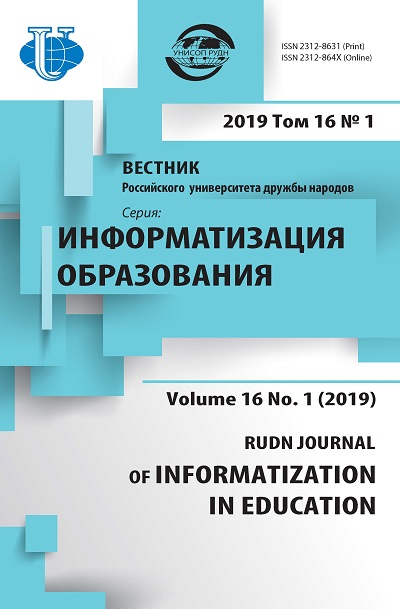ИКТ-инструменты для интернационализации непрерывного образования
- Авторы: Львова О.В.1
-
Учреждения:
- Московский городской педагогический университет
- Выпуск: Том 16, № 1 (2019)
- Страницы: 56-63
- Раздел: ИННОВАЦИОННЫЕ ПЕДАГОГИЧЕСКИЕ ТЕХНОЛОГИИ В ОБРАЗОВАНИИ
- URL: https://journals.rudn.ru/informatization-education/article/view/20842
- DOI: https://doi.org/10.22363/2312-8631-2019-16-1-56-63
Цитировать
Полный текст
Аннотация
Проблема и цель. Непрерывное образование представляет собой процесс роста образовательного (общего и профессионального) потенциала личности в течение всей жизни на основе использования системы государственных и общественных институтов в соответствии с потребностями личности и общества. Необходимость непрерывного образования обусловлена прогрессом науки и техники, широким применением инновационных технологий. Под интернационализацией понимают целенаправленный процесс интеграции международного, межкультурного или глобального измерения в цели, функции и обеспечение высшего образования с целью повышения качества образования и научных исследований для всех учащихся и сотрудников и внесения существенного вклада в жизнь общества. В наши дни информационные и телекоммуникационные технологии являются важной частью современного образовательного процесса и играют значительную роль в непрерывном образовании, обеспечивая его нужды различными ИКТ-инструментами, однако в зависимости от предлагаемого подхода непрерывное образование обладает и определенной спецификой. Соответственно, возникает потребность в различных информационных и телекоммуникационных технологиях и методах их применения. Чтобы эффективно использовать информационные и телекоммуникационные технологии для решения задач непрерывного образования, необходимо четко соотносить цели непрерывного образования и потенциал тех или иных ИКТ-инструментов. Методология. Рассмотрены различные способы применения информационных и телекоммуникационных технологий для интернационализации непрерывного образования. Проанализирована область применения различных ИКТ-инструментов и возможности их использования для решения задач интернационализации непрерывного образования с учетом специфики этой деятельности. Результаты. В настоящее время интернационализация образования и развитие непрерывного образования являются важными процессами мирового уровня. При этом в ходе интернационализации высшего образования наблюдается несколько основных тенденций использования хорошо развитых и широко применяемых ИКТ-инструментов/технологий. Большинство из указанных ИКТ-инструментов/технологий могут быть использованы также и в непрерывном образовании для решения аналогичных задач. При этом новые ИКТ-инструменты/ технологии - виртуальная мобильность, дистанционная академическая мобильность и электронная интернационализация - имеют значительные, однако еще недостаточно используемые возможности для решения задач именно непрерывного образования. Заключение. Показано, что информационные и телекоммуникационные технологии обеспечивают интернационализацию непрерывного образования не только хорошо известными ИКТ-инструментами/технологиями, но и новыми, обладающими широкими возможностями в этой области.
Об авторах
Ольга Владимировна Львова
Московский городской педагогический университет
Автор, ответственный за переписку.
Email: olglvova@yandex.ru.ru
кандидат педагогических наук, доцент кафедры информатизации образования
Российская Федерация, 127521, Москва, ул. Шереметьевская ул., 29Список литературы
- Григорьев С.Г., Гриншкун В.В., Львова О.В. Использование средств информатизации для формирования толерантности при обучении в течение всей жизни // Вестник Московского городского педагогического университета. Серия: Информатика и информатизация образования. 2016. № 1 (35). С. 8-19.
- Гриншкун В.В. Развитие интегративных подходов к созданию средств информатизации образования. URL: http://www.dissertations/archive/index.php (дата обращения: 10.10.2018).
- Пушкарёв Ю.В., Пушкарёва Е.А. Непрерывное образование в современных условиях: основные концептуальные подходы // Вестник Новосибирского государственного педагогического университета. 2015. № 6 (28). С. 161-171.
- Филиппов В.М. Интернационализация высшего образования: основные тенденции, проблемы и перспективы // Вестник Российского университета дружбы народов. Серия: Международные отношения. 2015. № 3. С. 203-211.
- Beelen J., Leask B. Internationalization at home on the move. Berlin: Dr. Josef Raabe Verlag, 2011. 204 p.
- Bremer L., Van der Wende M. Internationalizing the curriculum in higher education. The Hague: Nuffic, 1995. 74 p.
- Coelen R.J. Ranking and the measurement of success in internationalisation: are they related? Amsterdam, 2009. Pp. 39-48.
- Commission of the European Communities: adult learning: it is never too late to learn. Brussels, 2006. 89 p.
- Crowther P., Joris M., Otten M., Nilsson B., Teekens H., Wächter, B. Internationalisation at home: a position paper. Amsterdam: EAIE, 2001. 45 p.
- Department of Education and Science. Learning for Life: Paper on Adult Education. Dublin: Stationery Office, 2000. 112 p.
- De Wit H. Erasmus at 25: What is the future for international student mobility? URL: www. theguardian.com/guardian-professional (дата обращения: 10.10.2018).
- Elspeth J., Jos B., Robert C., de Wit H. Local and Global Internationalisation // Sense Publishers. Dordrecht, 2016. 88 p.
- Fenwick T., Nesbit T., Spencer B. Contexts of adult education: Canadian perspectives. Toronto: Thompson Educational Publ., 2006. P. 17.
- Fischer G. Lifelong Learning - More than Training // Journal of Interactive Learning Research. 2000. Vol. 11. Pp. 265-294.
- Grubb N. Vocational Education and Training: Issues for a Thematic Review. OECD. November, 2006. 39 p.
- Hudzik J. Comprehensive internationalization: from concept to action. Washington: NAFSA, 2011. 231 p.
- Knight J. Updating the definition of internationalization // International Higher Education. 2003. Pp. 2-3.
- Leask B. Using formal and informal curricula to improve interactions between home and international students // Journal of Studies in International Education. 2009. Vol. 13 (2). Pp. 205- 221.
- Merriam Sh., Brockett R. The Profession and Practice of Adult Education: an Introduction. JosseyBass, 2007. P. 7.
- Rizvi F. Internationalizing the curriculum in higher education. Paris, 1996. 54 p.
- Spencer B. The purposes of adult education: a short introduction. Toronto: Thompson Educational Publ., 2006. Pp. 9-10.
- TeaCamp. URL: http://teacamp.vdu.lt/content/about-project-0 (дата обращения: 10.10.2018).
















